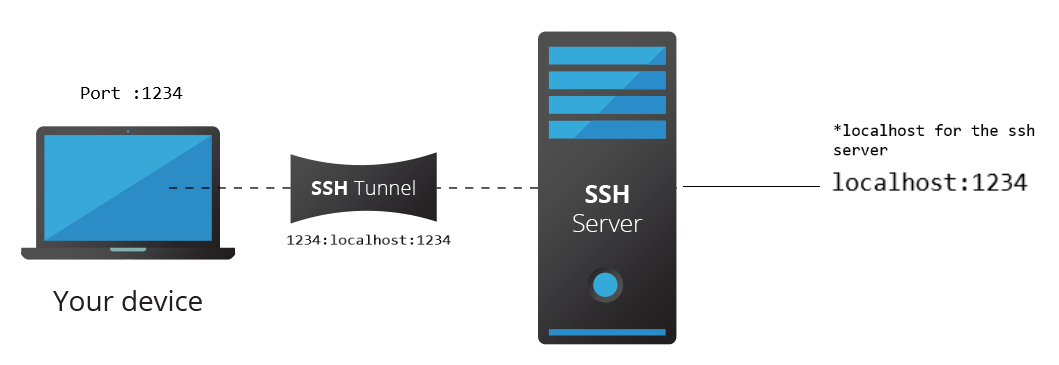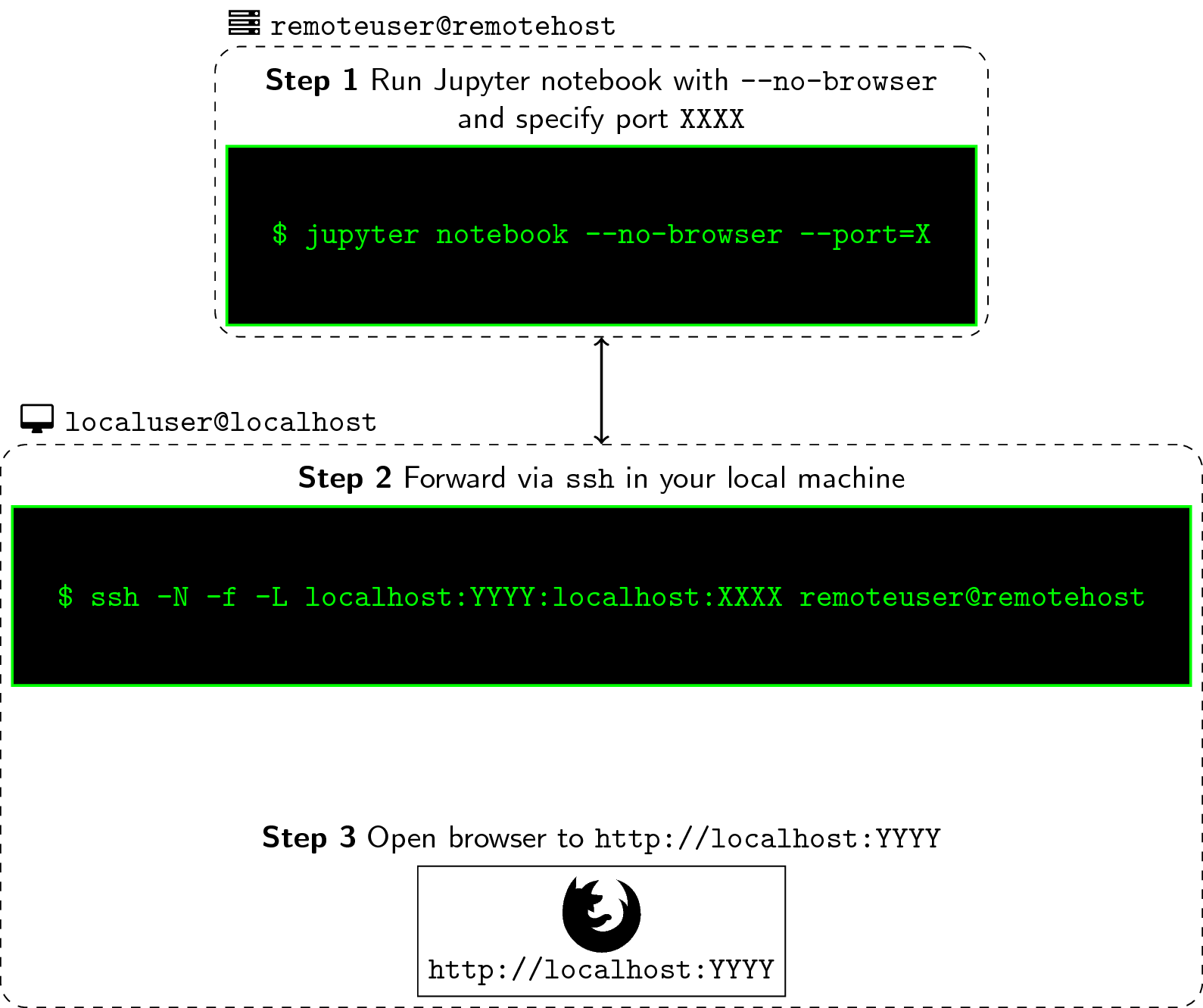Dont forget to change jer and remote-machine to your user and machine name. Jupyter notebook nobrowser.

Use Jupyter Notebook Remotely Pytraj 2 0 2 Dev0 Documentation
The firewall must also allow connections from 127001 localhost on ports from 49152 to 65535.

. Viewed 685 times 2 begingroup I would like to train my model faster and thats why would like to create a standalone remote machine with GPU support. You can start the notebook server from the command line using Terminal on MacLinux Command Prompt on Windows by running. RUN JUPYTER IN REMOTE SERVER outssh -T usernameserverIP.
Steps to Run a Remote Jupyter Notebook. In most cases this is simply done via an ssh command. How to run Jupyter Notebooks on remote server SSH Using SSH Tunneling Using Reverse Proxy.
Lets run Jupyter notebook remotely with a commend below. Run Notebook with Specified Port Number. This will print some information about the notebook server in your terminal including the URL of the web application by default httplocalhost8888.
Specify local or remote Jupyter server for connections command from the Command Palette P Windows Linux CtrlShiftP. Jupyter notebook --no-browser --port8889. Once logged in to the remote server cd to the desired directory and run the following command.
Jupyter notebook --no-browser --portXXXX Note. On the remote machine start jupyter notebook from your current directory and specify the port. To connect to a remote Jupyter server.
Modified 2 months ago. To function correctly the firewall on the computer running the jupyter notebook server must be configured to allow connections from client machines on the access port cNotebookAppport set in jupyter_notebook_configpy to allow connections to the web interface. Just a normal SSH login.
Ssh jer remote -machine. RunAccess Jupyter Notebook From Remote Server. Steps to Run Jupyter Notebook Remotely 1.
Jupyter notebook --no-browser --port9999 On the local machine catch the forwarded port. Select the Jupyter Server. Optional On the remote -machine run tmux.
If you have everything configured correctly you can run Jupyter kernels as the remote notebook user. Its totally the same of first way So it remains typing password. Session Steps to Run a Remote Jupyter Notebook.
Replace with your username and server address. How to run Jupyter Notebooks on remote server SSH Using SSH Tunneling Using Reverse Proxy. Back out of your running Jupyter notebook on the remote and run jupyter notebook password.
Get Jupyter notebook on both the remote and local machine. Running Jupyter notebook on remote server with local files. It will start the Jupyter Notebook on the specified port number.
Once connected code cells run on the remote server rather than the local computer. Ssh into the remote-machine. You will see like this.
Start the notebook in no-browser mode and specify a port different from any other port on the server. Fi cd jupyter Create a script to run jupyter echo jupyter notebook --no-browser -. Optional On the remote-machine run tmux.
Run jupyter notebook in the remote host without browser. Change XXXX to the port of your choice. RunAccess Jupyter Notebook From Remote Server.
Usually the default is 8888. Ssh -NfL localhost9999localhost9999 your_user_nameremote_ip_address Go to. When youre logged into your remote via ssh you can.
In the local computer open the command line tool I use Git Bash for Windows and type the following command. The solution I am looking for is to have the data locally on my. Ssh into the remote -machine.
Dont forget to change jer and remote -machine to your user and machine name. Ask Question Asked 1 year 9 months ago. Just a normal SSH login.
You can either if you havent set a password insert the token that should be displayed a bunch of letters and numbers in the remote or if you dont see this youll need to set a password. It will start the Jupyter Notebook on the specified port number. Once the console shows type the following.
Local button in the global Status bar or run the Jupyter. Log-in to your remote machine the usual way you do. Usually the default is 8888.
If your remote session gets disconnected tmux will keep the session running to reconnected run tmux attach. This will prompt you to write and verify a password which. You should see something like this.
Ssh -N -f -L. Login to Remote Server. We will now create a configured server because remote servers are configured servers where the local ones are the managed ones.
Run Notebook with Specified Port Number. Map Local Port to Remote Port. How To Run An IPythonJupyter Notebook On A Remote.
This is a Jupyter password. On a zOS system just like any others we have users. This concept may be a bit confusing so let me try to explain.
Replace with your username and server address. Running A Jupyter Notebook From A Remote Server Select the Jupyter Server. Just do it and then you can usually use jupyter notebook on the remote web browser like this.
From the top tab of the ipynb file open Configure Jupyter Server. And if you type your IP Addressport number on web browser. One such user will run the Jupyter Kernel Gateway server.
Login to Remote Server.

Tips For Running Jupyter Notebook On Remote Server Just Chillin

Tips For Running Jupyter Notebook On Remote Server Just Chillin

How To Run Jupyter Notebooks On Remote Server Ssh By Pranav Gajjewar Medium

How To Install Run And Connect To Jupyter Notebook On A Remote Server Digitalocean

Running Jupyter Notebooks On A Remote Server Via Ssh Tech Talk Tone

How To Install Run And Connect To Jupyter Notebook On A Remote Server Digitalocean

How Can Connect Jupyter Notebook In Desired Environment In Anaconda In Server Computer By Using Putty Stack Overflow

0 comments
Post a Comment